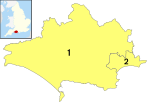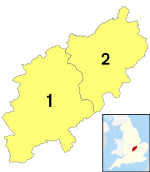
Metropolitan counties are a subdivision of England which were originally used for local government. There are six metropolitan counties: Greater Manchester, Merseyside, South Yorkshire, Tyne and Wear, West Midlands and West Yorkshire.

The counties of England are divisions of England. There are currently 48 ceremonial counties, which have their origin in the historic counties of England established in the Middle Ages. The current ceremonial counties are the result of the Lieutenancies Act 1997 and are based on the Local Government Act 1972 administrative counties which included a number of new counties such as Greater Manchester and Tyne and Wear. However, some counties introduced by the Local Government Act 1972, including Avon, Cleveland and Humberside no longer exist. The term "county", relating to any of its meanings, is used as the geographical basis for a number of institutions such as police and fire services, sports clubs and other non-government organisations.

The Redcliffe-Maud Report was published in 1969 by the Royal Commission on Local Government in England, under the chairmanship of Lord Redcliffe-Maud. Although the commission's proposals were broadly accepted by the Labour government, they were set aside by the Conservative government elected in 1970.

The North East England devolution referendum was an all postal ballot referendum that took place on 4 November 2004 throughout North East England on whether or not to establish an elected assembly for the region. Devolution referendums in the regions of Northern England were initially proposed under provisions of the Regional Assemblies (Preparations) Act 2003. Initially, three referendums were planned, but only one took place. The votes concerned the question of devolving limited political powers from the UK Parliament to elected regional assemblies in North East England, North West England and Yorkshire and the Humber respectively. Each were initially planned to be held on 4 November 2004, but on 22 July 2004 the planned referendums in North West England and in Yorkshire and the Humber were postponed, due to concerns raised about the use of postal ballots, but the referendum in North East England was allowed to continue, particularly as it was assumed that the region held the most support for the proposed devolution.

The Local Government Act 1972 is an act of the Parliament of the United Kingdom that reformed local government in England and Wales on 1 April 1974. It was one of the most significant Acts of Parliament to be passed by the Heath Government of 1970–74.
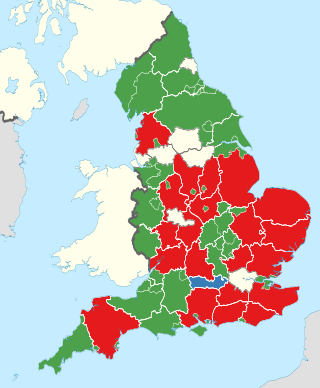
A non-metropolitan county, or colloquially, shire county, is a subdivision of England used for local government.

Metropolitan and non-metropolitan counties are one of the four levels of subdivisions of England used for the purposes of local government outside Greater London and the Isles of Scilly. As originally constituted, the metropolitan and non-metropolitan counties each consisted of multiple districts, had a county council and were also the counties for the purposes of Lieutenancies. Later changes in legislation during the 1980s and 1990s have resulted in counties with no county council and 'unitary authority' counties with no districts. Counties for the purposes of Lieutenancies are now defined separately, based on the metropolitan and non-metropolitan counties.

Somerset Council, known until 1 April 2023 as Somerset County Council, is the unitary authority which governs the district of Somerset, which occupies the southern part of the ceremonial county of the same name in the South West of England. The council has been controlled by the Liberal Democrats since the 2022 local elections, and its headquarters is County Hall in Taunton.

The unitary authorities of England are a type of local authority responsible for all local government services in an area. They combine the functions of a non-metropolitan county council and a non-metropolitan district council, which elsewhere in England provide two tiers of local government.

The Local Government Commission for England was the body responsible for reviewing the structure of local government in England from 1992 to 2002. It was established under the Local Government Act 1992, replacing the Local Government Boundary Commission for England. The Commission could be ordered by the Secretary of State to undertake "structural reviews" in specified areas and recommend the creation of unitary authorities in the two-tier shire counties of England. The Commission, chaired by John Banham, conducted a review of all the non-metropolitan counties of England from 1993 to 1994, making various recommendations on their future.
The history of local government in Yorkshire is unique and complex. Yorkshire is the largest historic English county and consists of a diverse mix of urban and rural development with a heritage in agriculture, manufacturing, and mining. After a long period with little change, it has been subject to a number of reforms of local government structures in modern times, some of which were controversial. The most significant of these were the Local Government Act 1972, the 1990s UK local government reform, and the Localism Act 2011. The historic area currently corresponds to several counties and districts and is mostly contained within the Yorkshire and the Humber region.

On 1 April 2009 structural changes to local government in England took place which reformed the local government of seven non-metropolitan counties: Bedfordshire, Cheshire, Cornwall, County Durham, Shropshire, Northumberland, and Wiltshire. In each case the government of the county was changed from a two-tier to a unitary system, with Bedfordshire and Cheshire being divided into two new unitary authorities.

Cumbria County Council was the county council for the non-metropolitan county of Cumbria in the North West of England. Established in April 1974, following its first elections held the previous year, it was an elected local government body responsible for the most significant local services in the area, including schools, roads, and social services.

North Yorkshire Council, is the unitary authority which governs the non-metropolitan county of North Yorkshire, within the larger ceremonial county of North Yorkshire, in England. North Yorkshire was a two-tier non-metropolitan county from 1974 to 2023, when North Yorkshire Council was a county council called North Yorkshire County Council. On 1 April 2023 the seven lower-tier districts of the county were abolished and their functions taken over by the new unitary authority.

A combined authority is a type of local government institution introduced in England outside Greater London by the Local Democracy, Economic Development and Construction Act 2009. Combined authorities are created voluntarily and allow a group of local authorities to pool appropriate responsibility and receive certain delegated functions from central government in order to deliver transport and economic policy more effectively over a wider area.

City of York Council is the municipal governing body of the City of York, a unitary authority in Yorkshire, England. It is composed of 47 councillors, one, two, or three for each of the 21 electoral wards of York. It is responsible for all local government services in the City of York, except for services provided by York's town and parish councils.

The 2015 United Kingdom local elections were held on Thursday 7 May 2015, the same day as the general election for the House of Commons of the United Kingdom.
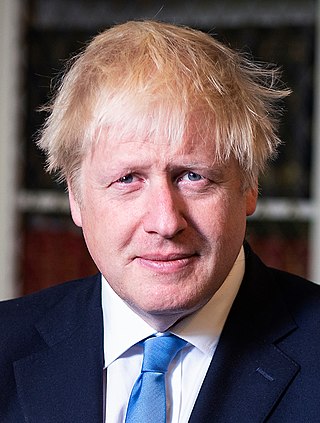
The 2021 United Kingdom local elections were held on Thursday 6 May 2021. More than 145 English local councils, around 5,000 councillor seats, thirteen directly elected mayors in England, and 39 police and crime commissioners in England and Wales were contested. On the same day, the 2021 Hartlepool by-election took place, and there were also elections to the Scottish Parliament, Senedd and London Assembly, the last in conjunction with the London mayoral election.
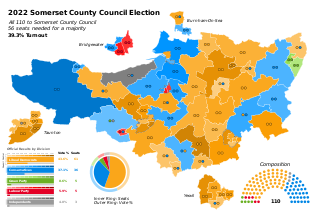
The 2022 Somerset Council election took place on 5 May 2022. It was the inaugural election of the new unitary authority, Somerset Council, which replaced Somerset County Council on 1 April 2023. All 110 councillors were elected, representing the same divisions as the old county council, but with twice as many councillors representing each. The councillors elected first sat as members of the existing county council until its replacement by the new authority. The same councillors are now members of Somerset Council.

Westmorland and Furness is a unitary authority area in Cumbria, England, which means that is a non-metropolitan county and district. The economy is mainly focused on tourism around both the Lake District and Cumbria Coast, shipbuilding and the port in Barrow-in-Furness, and agriculture in the rural parts of the area.

